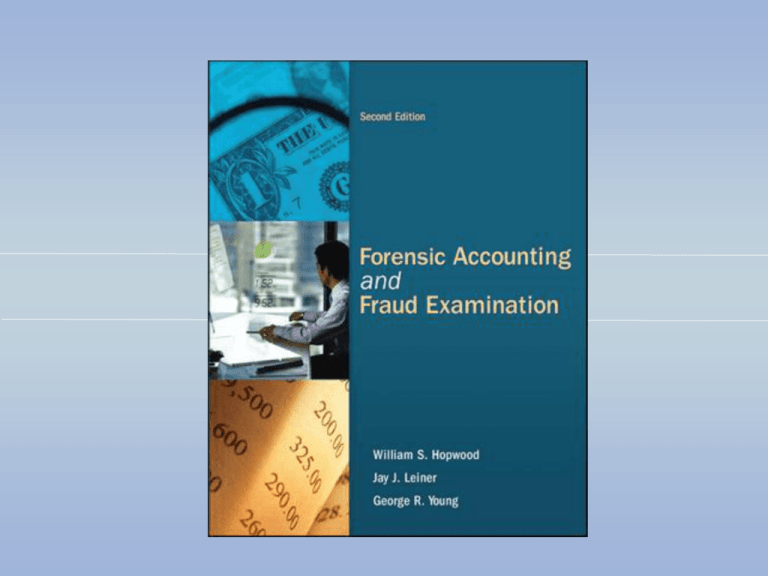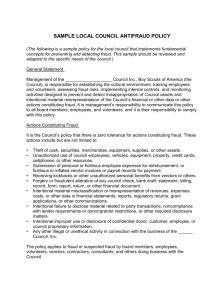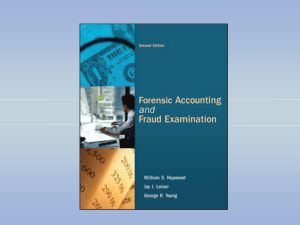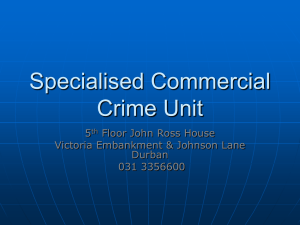
9-1
9-2
09
Fraud Examination Evidence I:
Physical, Documentary, and
Observational Evidence
McGraw-Hill/Irwin
Copyright © 2012 by The McGraw-Hill Companies, Inc. All rights reserved.
9-3
Advanced Evidence Concepts
As
previously discussed, evidence from the point of view of
an investigator is anything that relates to the truth or falsity
of an assertion made in an investigation or legal
proceeding; it includes physical objects, documents,
observations, and interviews.
In an investigation, “evidence” has absolutely no meaning
at all unless it relates to some fraud theory.
In a court room setting evidence is defined in terms of the
courts’ rules of evidence, what is admissible in court, trial
strategy, and how it is viewed by judges, juries, and
attorneys.
Courtroom lawyers may refer to physical, testimonial,
documentary, and demonstrative evidence.
9-4
Physical Evidence
Physical
Evidence is tangible
Refers
to a relative broad category of evidence that includes
fingerprints and trace evidence.
For example, physical evidence can include forged signatures on
documents
Physical
evidence must not be contaminated
9-5
Documents and Records
Documents
(including records in electronic format) are the
most often used type of evidence in fraud investigations.
Basic rules for documents:
1.
Obtain original documents if possible (the credibility of a
case is enhanced by having original documents).
2. Keep them in a secure location so that access is restricted.
3. Make copies of the original documents; use copies in the
investigation, originals in court.
4. Handle originals as few times as possible; they might later
be used for fingerprint analysis.
5. Maintain appropriate chain of custody records.
9-6
The Application of Link Analysis
to Document Evidence
Link
analysis is a process that allows information in various
databases and files to be evaluated and integrated in such
a way that associations become apparent.
Various software programs are available for link analysis.
The analysis can be used to point to suspects, locate
hidden assets, or point to areas or issues that require
additional investigation.
9-7
Analytical Procedures
When
a suspected fraud is either, for example, an
embezzlement or a misstatement of financial statements,
the forensic accountant can use analytical procedures to
gather evidence that can lead to the determination of who,
what, when, and why regarding the fraud.
Analytical procedures provide evidence of areas that are
likely to contain fraud. The do not prove fraud.
Analytical procedures can be used for both detection and
investigation.
9-8
Common Types of Analytical
Procedures
Five
common types of analytical procedures:
Comparison
of financial data with prior period financial data
Comparison of financial data with industry data
Comparison of expected financial results with nonfinancial
data
Comparison of financial data with results expected by the
entity itself
Comparison of data with results expected by the forensic
accountant (e.g., expected decline due to downturn in
economy)
9-9
Questioned Document Analysis –
Suspicious Documents
Examples
of suspicious document symptoms:
Signature
appears to be contrived.
Date on document is not consistent with other evidence.
Paper does not seem to be the type usually used for the
purpose.
Document is a copy when original was expected.
Erasures or a covering agent, such as a fluid correction coverup, is present.
If document is in electronic form, different styles or sizes of
fonts were used.
Document numbers appear to be out of sequence.
Checks have second endorsements.
9-10
Questioned Documents
Documents
that generate suspicions are called questioned
documents
Documents
are questioned because their authorship or
authenticity, or both, is in doubt
Document
examiners specialize in analyzing questioned
documents. They may consider things such as handwriting,
printer output, and ink and paper used in documents
Altered documents may have either deletions or insertions,
or both
Document forgery is greatly facilitated by personal
computers and desktop publishing software
9-11
Observation
Observation
involves the use of the senses to assess the
propriety of the behavior of persons and other activities
such as business processes that have a tangible
component.
Three types of observational evidence: surveillance,
invigilation, and co-worker testimony.
Evidence provided through observation is often the most
convincing and the easiest evidence for juries to
understand.
9-12
Choosing the Appropriate
Evidence-Gathering Technique
To
choose the appropriate technique, the forensic
accountant should consider the following factors:
The
type of fraud believed to have been perpetrated;
The fact that the fraud is or is not ongoing;
The extent of the fraud;
The extent to which the investigation can be kept secret;
The condition of the financial records, other source
documents, and physical evidence;
The sophistication of the suspect and whether collusion exists;
The cost of applying a given method;
The psychological and organizational impact of applying the
given method;
The objectives of the investigation.







